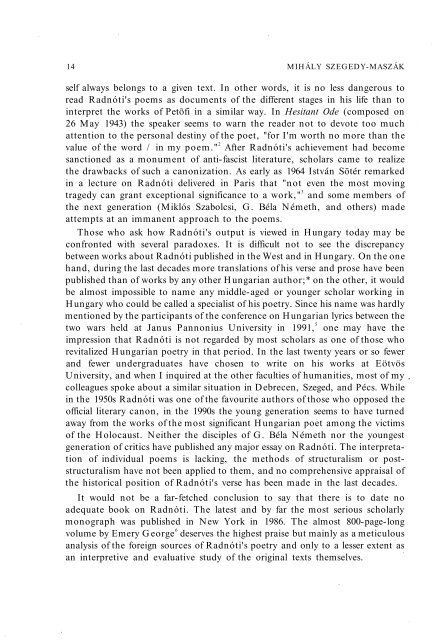HUNGARIAN STUDIES 11. No. 1. Nemzetközi Magyar ... - EPA
HUNGARIAN STUDIES 11. No. 1. Nemzetközi Magyar ... - EPA
HUNGARIAN STUDIES 11. No. 1. Nemzetközi Magyar ... - EPA
- No tags were found...
You also want an ePaper? Increase the reach of your titles
YUMPU automatically turns print PDFs into web optimized ePapers that Google loves.
14 MIHÁLY SZEGEDY-MASZÁKself always belongs to a given text. In other words, it is no less dangerous toread Radnóti's poems as documents of the different stages in his life than tointerpret the works of Petőfi in a similar way. In Hesitant Ode (composed on26 May 1943) the speaker seems to warn the reader not to devote too muchattention to the personal destiny of the poet, "for I'm worth no more than thevalue of the word / in my poem." 2After Radnóti's achievement had becomesanctioned as a monument of anti-fascist literature, scholars came to realizethe drawbacks of such a canonization. As early as 1964 István Sőtér remarkedin a lecture on Radnóti delivered in Paris that "not even the most movingtragedy can grant exceptional significance to a work," 3and some members ofthe next generation (Miklós Szabolcsi, G. Béla Németh, and others) madeattempts at an immanent approach to the poems.Those who ask how Radnóti's output is viewed in Hungary today may beconfronted with several paradoxes. It is difficult not to see the discrepancybetween works about Radnóti published in the West and in Hungary. On the onehand, during the last decades more translations of his verse and prose have beenpublished than of works by any other Hungarian author;* on the other, it wouldbe almost impossible to name any middle-aged or younger scholar working inHungary who could be called a specialist of his poetry. Since his name was hardlymentioned by the participants of the conference on Hungarian lyrics between thetwo wars held at Janus Pannonius University in 1991, 5one may have theimpression that Radnóti is not regarded by most scholars as one of those whorevitalized Hungarian poetry in that period. In the last twenty years or so fewerand fewer undergraduates have chosen to write on his works at EötvösUniversity, and when I inquired at the other faculties of humanities, most of mycolleagues spoke about a similar situation in Debrecen, Szeged, and Pécs. Whilein the 1950s Radnóti was one of the favourite authors of those who opposed theofficial literary canon, in the 1990s the young generation seems to have turnedaway from the works of the most significant Hungarian poet among the victimsof the Holocaust. Neither the disciples of G. Béla Németh nor the youngestgeneration of critics have published any major essay on Radnóti. The interpretationof individual poems is lacking, the methods of structuralism or poststructuralismhave not been applied to them, and no comprehensive appraisal ofthe historical position of Radnóti's verse has been made in the last decades.It would not be a far-fetched conclusion to say that there is to date noadequate book on Radnóti. The latest and by far the most serious scholarlymonograph was published in New York in 1986. The almost 800-page-longvolume by Emery George 6 deserves the highest praise but mainly as a meticulousanalysis of the foreign sources of Radnóti's poetry and only to a lesser extent asan interpretive and evaluative study of the original texts themselves.
















